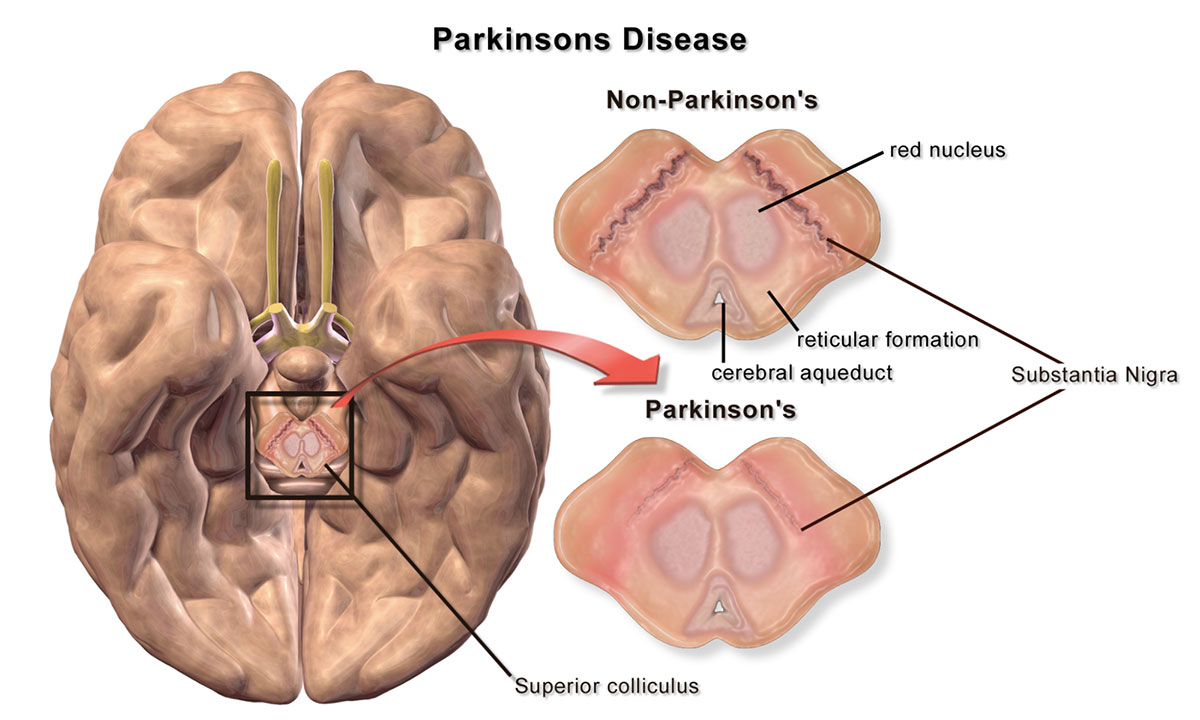Parkinson’s disease (PD) is one of the most widespread neurodegenerative diseases that brings a lot of discomfort to people of older age. According to the Parkinson Foundation organization, nearly 60 thousand Americans are diagnosed with Parkinson’s disease annually. Living with Parkinson’s is hard enough as it causes motor dysfunction and lots of everyday things become complicated to perform. Most patients end up making routine tasks such as brushing teeth and walking only with external assistance.
Unfortunately, modern approaches in treating PD aren’t effective enough, and some of them cause severe side effects. Modern scientists continue to research alternative ways to manage PD. Stem cell therapy is one of them. In this article, we discuss the perspectives of stem cells for Parkinson’s disease in 2022.
Parkinson’s disease: definition and symptoms
Dopamine is known as a pleasure hormone, but its role isn’t limited to controlling our reward system. Dopamine is an important neurotransmitter that regulates cell communication in our neural system. It’s also responsible for motor function. Dopamine triggers skeletal muscle tone. This is why we can write with a pen, walk, do sports, etc.
Parkinson’s disease occurs when a little part of our brain called substantia nigra loses too many dopaminergic neurons. The common age for developing PD is 60 years. The scientific community considers PD is caused by genetics and environmental conditions. However, the exact reason causing neural cells to die in substantia nigra is still unknown. Risk factors for PD include:
- Gender. Men are more prone to PD than women.
- Age. Elderly people are likely to develop PD. Young-onset PD is diagnosed in people younger than 50 years.
- Genetics. Some patients have inheritance patterns that lead to higher risks of gaining PD.
- Environment. Scientists discovered a connection between chemicals used in agriculture and Parkinson’s disease.
- Brain damage. Severe head injuries may cause the development of PD.

Parkinson’s is a progressive disease. It’s developed in five stages.
Parkinson’s disease symptoms:
- Stage 1. Tremor on one side of the body, posture changes, facial expressions.
- Stage 2. Tremor is developing on both sides of the body, rigidity.
- Stage 3. Problems with balance, slow movements and falls, and difficulties with eating and dressing.
- Stage 4. A patient is unable to live alone, difficulty walking without support.
- Stage 5. Leg stiffness, cognitive dysfunction.
The current approach to treating PD
Society still doesn’t have a cure for Parkinson’s disease. However, there are plenty of therapies and drugs aimed to replace dopamine or mimic its production. Most of the current approaches in treating PD reduce the symptoms for some time. Unfortunately, the disease continues to progress even if patients take medications or undergo surgical operations.
The most prescribed drug for PD symptoms relief is Levodopa. Levodopa is an oral medication that contains L-DOPA amino acid, which transforms to dopamine in the human body. Levodopa causes spikes of dopamine in our brain, but cells that convert it continue to die. When Levodopa reaches its potential, patients experience involuntary muscle movements.
Besides medications, many patients try deep-brain stimulation (DBS). A surgeon puts electrodes in the brain and electric impulses prevent involuntary movements. DBS also loses its potency with time.
Can stem cell therapy treat Parkinson’s disease in 2022?
Stem cell therapy has the potential to reduce PD symptoms and restore dopaminergic neurons in the brain of patients with Parkison’s.
What is stem cell treatment?
Stem cell treatment is a regenerative medicine that uses stem cells to repair damaged or dysfunctional tissue in a human body. Stem cells therapy is used to treat some immune and blood-related diseases and for recovery after chemotherapy. Stem cells are basic cells that can be transformed into cells of different types. A doctor delivers stem cell transplants into damaged organs where implanted cells promote tissue repair.

Types of stem cells
Before stem cell transplantation, a doctor should harvest stem cells. Stem cells originate from bone or fat tissue, as well as cord blood and embryos (in-vitro fertilization without implantation). Several types of stem cells have the potential to reduce PD symptoms.
Fetal Ventral Mesencephalic Cells
Transplantation of dopamine-rich mesencephalic neurons from embryos to rodents and primates has shown behavioral deficits improvements. Moreover, the first clinical trials on humans led to a moderate decrease in PD symptoms. However, using fetal ventral mesencephalic cells raises ethical concerns as these cells are derived from donor embryos 6-9 weeks of age that have never been implanted into the uterus. Standardizing such a procedure is currently difficult.
Human Embryonic Stem Cells
Embryonic stem cells are harvested from early embryonic blastocyst when providing in vitro fertilization. Embryonic stem cells can generate different cell lines, including dopaminergic neurons. Controlling blastocysts maturation is a challenging task.
Human-Induced Pluripotent Stem Cells (hiPSCs)
Pluripotent stem cells can be produced from somatic cells taken from adult tissue. Pluripotent stem cells can also proliferate indefinitely and generate different types of cells. With pluripotent stem cells, there’s no need to ruin pre-implanted embryos. Moreover, each patient can receive personalized stem cells originated from their bodies, which eliminates the risks of immune rejection. Stem cells can replace damaged neurons in the human midbrain and reduce PD symptoms
Stem cells for Parkinson’s disease
When using stem cells for treating Parkinson’s in 2022, a subjective improvement has been observed in symptoms like facial expression, gait, and freezing episodes. Some patients have significantly reduced the dosages of the usual PD medicine they’ve used. These results indicate that stem cell protocol seems to be safe, and no serious adverse events occurred after stem-cell transplantation in PD patients.
A number of scientists from Eastern countries and Europe work hard on assessing stem cell therapy benefits for Parkinson’s disease. Stem cells can replace damaged neurons in the human midbrain and reduce PD symptoms. Still, more trials are required to confirm the therapy’s safety and effectiveness.
Is stem cell therapy safe?
As stem cells take their origin from the patient’s tissue, there’s little to no risk of transplant rejection. Conducted clinical trials didn’t establish severe adverse effects of stem cells for Parkinson’s. Still, stem cell therapy for PD is under investigation, and more research is needed to get the therapy legally approved.
Interim studies show that stem cell therapy for patients with Parkinson’s disease reduces tremor and facial expressions. Also, many patients refuse medical treatment after stem cell transplantation.
Wrapping up
Parkinson’s disease is a severe and incurable medical condition that brings harm and discomfort. Current medicine is in search of effective and safe ways to reduce PD symptoms and prevent disease development, and stem cell therapy is one of them.
Stem cell therapy shows promising results in reducing Parkinson’s symptoms without provoking severe side effects. Stem cells for Parkinson’s are the unlimited source of dopaminergic neurons that usually die as PD progresses, so they should be replaced. FDA is currently supporting Parkinson’s disease stem cell therapy’s trial.
If you’re interested in stem cell therapy to reduce Parkinson’s symptoms, contact our specialists to discuss treatment options in detail for free.

